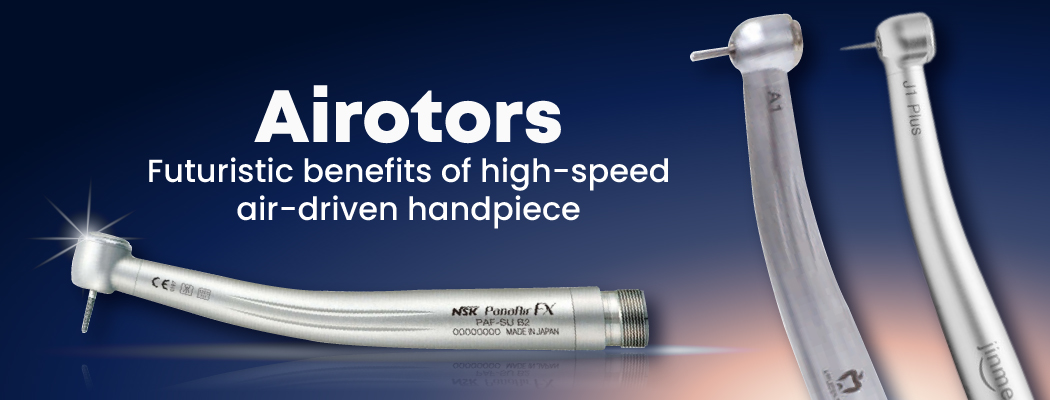An Airotor in dentistry is often a high-speed air-driven handpiece or turbine. It is a dental tool that rapidly rotates a bur or cutting tool using pressurized air. The airotor is frequently used in a number of dental treatments, including removing decaying tooth structures and preparing the tooth for a crown.
The NSK Airotor Handpiece Pana Air handpiece's fast rotating speed enables quick removal of tooth material, making it ideal for efficient and accurate cutting. It frequently works in tandem with water spray to cool the bur and lower heat production when cutting. Doing this reduces the patient's discomfort and the tooth being treated is protected.
The Airotor handpiece is a vital instrument in most dental offices, and because of its speed and adaptability, it can be used for various dental treatments. It's important to remember that several types and models of airotors are available, each with unique characteristics and powers. Dentists frequently choose the best handpiece based on the operation being done and their own preferences.
Benefits of airotor:
The Airotor, often known as a high-speed air-driven handpiece, has various advantages in dentistry. The following are some benefits of employing an airotor:
- Efficiency: Airotors are made to function at high speeds, making material removal during dental operations rapid and efficient. This may shorten the length of the procedure and boost the dentist's output.
- Precision: The airotor handpiece's high rotating speed enables fine control over shaping and cutting tooth shapes. This degree of precision is particularly significant in operations like cavity preparation or crown preparation when accuracy is essential.
- Versatility: Airotors are flexible tools that may be used for a variety of dental treatments, such as cavity preparation, crown, and bridge work, removing decaying tooth structure, and more. They enable dentists to do a variety of jobs with a single handpiece by being compatible with various bur types and accessories.
- Comfort: Using high-speed airotors and water spray during cutting helps reduce heat production. This lessens the chance that the patient may feel pain, which might make their dental visit more enjoyable.
- Smooth Cutting: Airotors are renowned for their cutting action that is smooth, which can increase patient comfort and produce less vibration. When doing complex operations or working on delicate oral regions, this might be really helpful.
- Accessibility: Airotor handpieces are easier to use and more maneuverable, especially in difficult-to-reach parts of the oral cavity, thanks to their slender and compact form. This can help while doing dental operations to get the best outcomes possible.
Although Orikam Jinme Airotor J1 Plus has several advantages, it's crucial to remember that they are only one kind of dental handpiece. Depending on the operation, the patient's demands, and their own preferences, dentists may employ several handpieces.
Side effects of airotor:
- Heat generation: The airotor's high-speed spinning can produce heat, especially when operated constantly or for a long time. The tooth being treated may experience discomfort or thermal damage as a result of this heat. Dentists often address this by cooling the bur and reducing heat accumulation with water spray.
- Vibrations: Patients who have sensitive gums or teeth may experience pain from the vibrations caused by the airotor's high-speed rotation. The dentist may find it difficult to retain exact control during some operations due to these vibrations.
- Noise: The high-speed spinning and air compression of airotors can produce some noticeable noise. For certain individuals, especially those who are sensitive to loud sounds, this noise may cause worry or pain.
- Aerosol production: The usage of airotors, particularly during operations involving water spray, can produce aerosols. Saliva, blood, water, and microorganisms from the patient's mouth make up aerosols. In dental offices that adhere to stringent infection control standards, the danger of infection transmission by aerosols is often low, but it is still something to take into account.
- Tooth sensitivity: Using airotors during treatments that include preparing the tooth or removing deteriorated tooth structure can cause tooth sensitivity that may last for a short while or last for a long time. The underlying sensitive layers of the tooth may become exposed as a result of the loss of enamel or dentin, causing this discomfort.
It's crucial to remember that most of these adverse effects are mild and transient. Dentists take safety measures to reduce any dangers and pain that may be involved with using airotors. In order for the dentist to alter their technique or take the necessary steps to resolve the issue, patients should convey any worries or pain they feel during dental operations.
Future of airotor in Dentistry:
Apple Dental Airotor HandPiece B2 Model TU in dentistry are anticipated to see technology and design developments in the future that enhance their functionality, effectiveness, and patient comfort. Here are some potential directions for airotor development:
- Ergonomics: Manufacturers may concentrate on improving the airotors' ergonomic design to increase dentist comfort and lessen hand and wrist strain during extended use. This could entail the creation of lightweight materials, enhanced grip styles, and improved vibration-dampening systems.
- Noise reduction: To enhance patient comfort and lessen anxiety, efforts may be taken to diminish the noise produced by airotors. This can entail the application of cutting-edge sound-dampening materials or creative design adjustments that lower noise without sacrificing performance.
- Cooling and irrigation systems: Upgrades to these systems can increase patient comfort and stop heat accumulation during treatments. These improvements can include improved water flow regulation, more effective water spray systems, or the incorporation of cutting-edge cooling technology.
- Precision and cutting effectiveness: Upcoming airotors may provide even greater rotational speeds and enhanced cutting effectiveness to improve dental operations. This can entail the creation of more potent and effective air turbine systems or the incorporation of cutting-edge technology.
- Integration with digital dentistry systems: Airotors may be more seamlessly connected to and integrated with CAD/CAM and imaging systems as a result of increased integration with digital dentistry systems. This may make tooth preparation and restoration procedures more precise and effective.
- Infection control: Continued focus on infection control might lead to improvements in airotor design that would reduce the production of aerosols and improve sterilization processes. This might entail the creation of disposable components that lower the danger of cross-contamination or the incorporation of enhanced filtering systems.










